Unit 4 Where's my schoolbag?单元复习课件
文档属性
| 名称 | Unit 4 Where's my schoolbag?单元复习课件 | 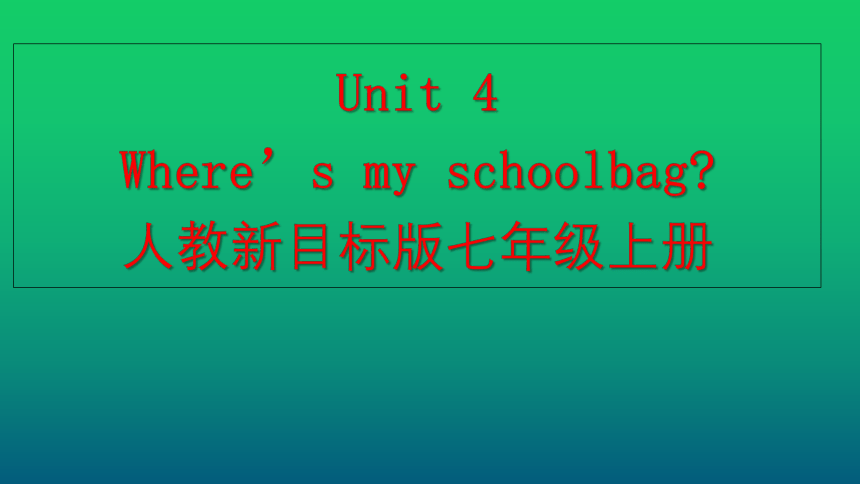 | |
| 格式 | zip | ||
| 文件大小 | 164.6KB | ||
| 资源类型 | 试卷 | ||
| 版本资源 | 人教新目标(Go for it)版 | ||
| 科目 | 英语 | ||
| 更新时间 | 2022-12-15 16:48:01 | ||
图片预览

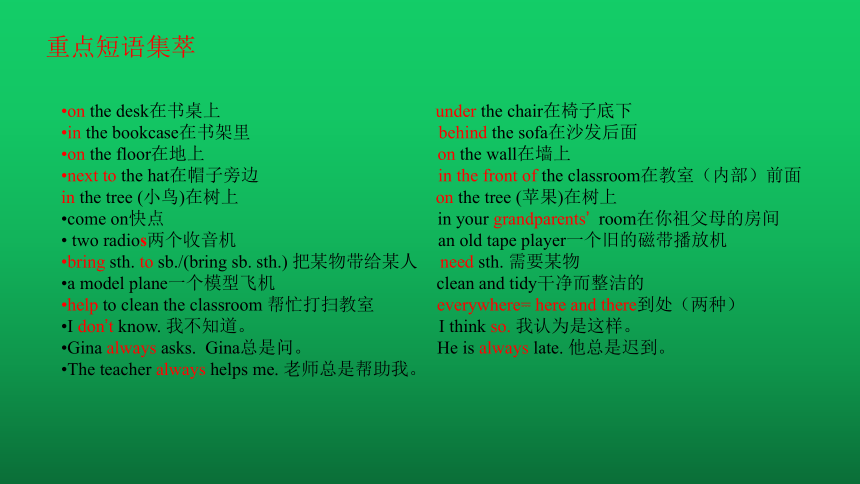
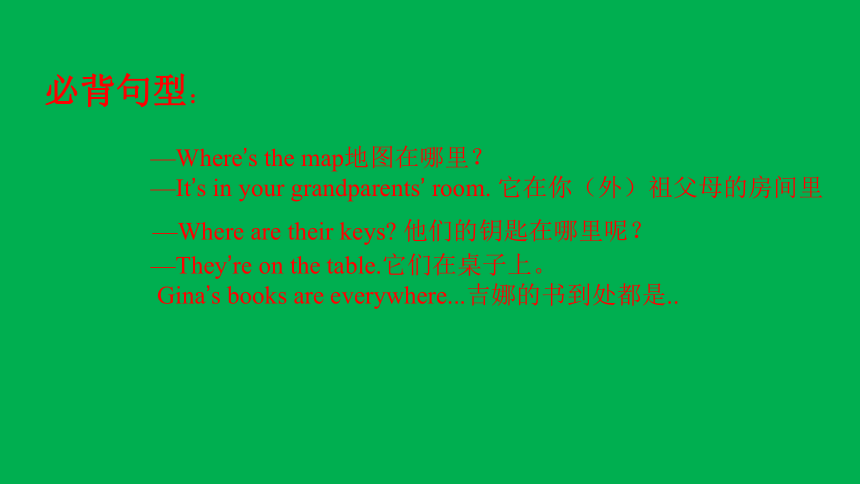
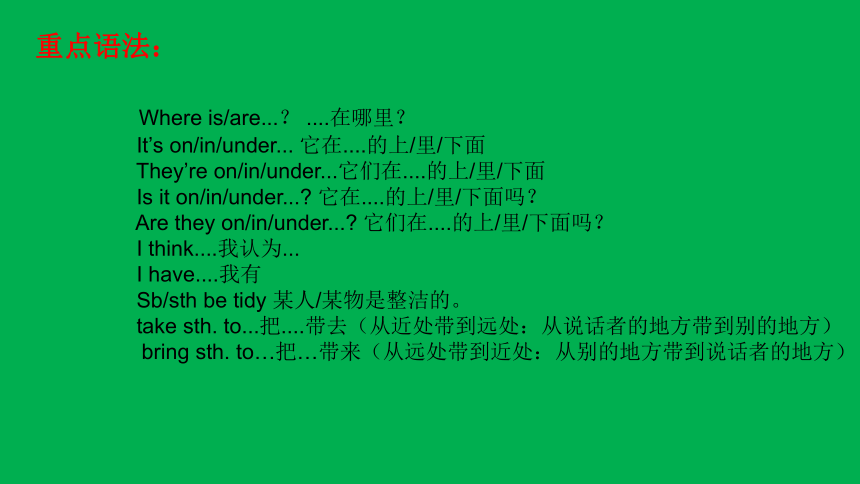
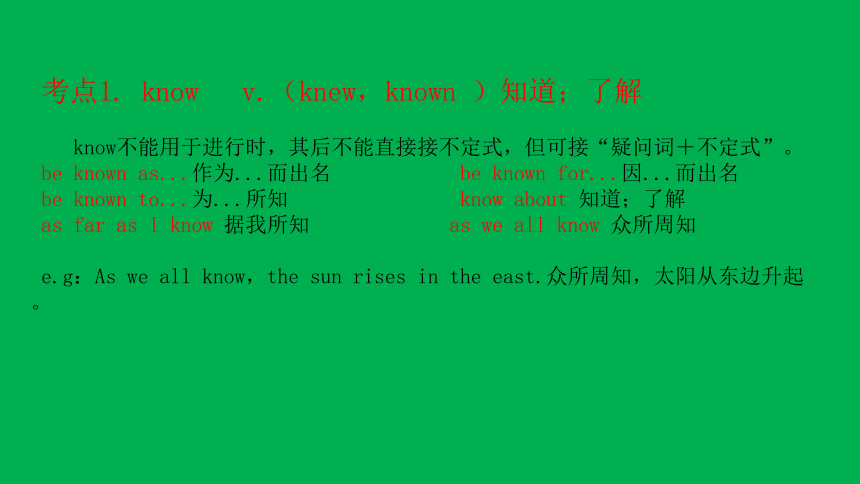
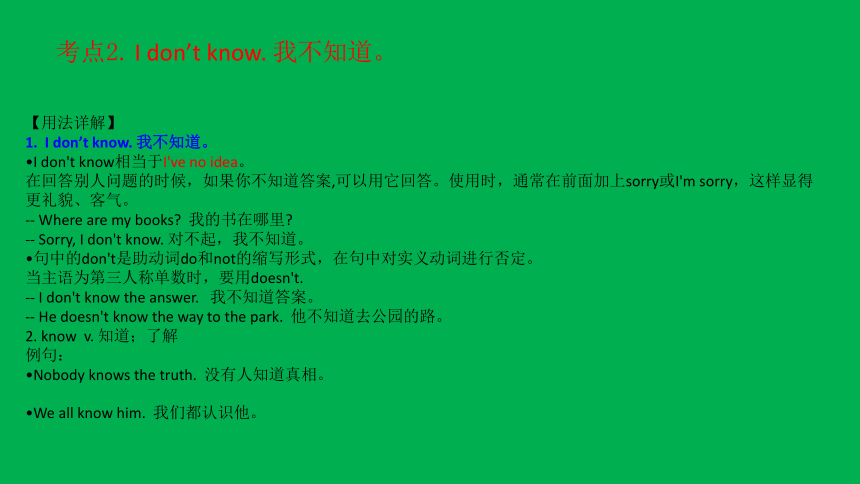
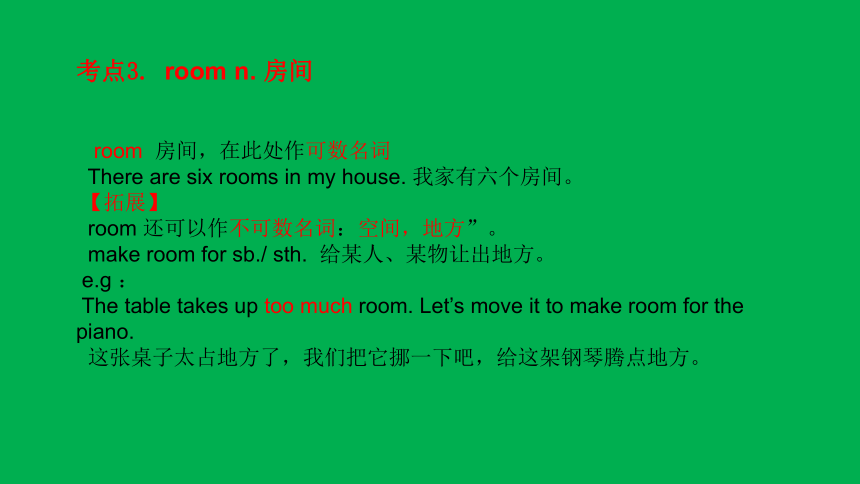
文档简介
(共17张PPT)
Unit 4
Where’s my schoolbag
人教新目标版七年级上册
on the desk在书桌上 under the chair在椅子底下
in the bookcase在书架里 behind the sofa在沙发后面
on the floor在地上 on the wall在墙上
next to the hat在帽子旁边 in the front of the classroom在教室(内部)前面
in the tree (小鸟)在树上 on the tree (苹果)在树上
come on快点 in your grandparents’ room在你祖父母的房间
two radios两个收音机 an old tape player一个旧的磁带播放机
bring sth. to sb./(bring sb. sth.) 把某物带给某人 need sth. 需要某物
a model plane一个模型飞机 clean and tidy干净而整洁的
help to clean the classroom 帮忙打扫教室 everywhere= here and there到处(两种)
I don’t know. 我不知道。 I think so. 我认为是这样。
Gina always asks. Gina总是问。 He is always late. 他总是迟到。
The teacher always helps me. 老师总是帮助我。
重点短语集萃
必背句型:
—Where’s the map地图在哪里?
—It’s in your grandparents’ room. 它在你(外)祖父母的房间里
—Where are their keys 他们的钥匙在哪里呢?
—They’re on the table.它们在桌子上。
Gina’s books are everywhere...吉娜的书到处都是..
重点语法:
Where is/are...? ....在哪里?
It’s on/in/under... 它在....的上/里/下面
They’re on/in/under...它们在....的上/里/下面
Is it on/in/under... 它在....的上/里/下面吗?
Are they on/in/under... 它们在....的上/里/下面吗?
I think....我认为...
I have....我有
Sb/sth be tidy 某人/某物是整洁的。
take sth. to...把....带去(从近处带到远处:从说话者的地方带到别的地方)
bring sth. to…把…带来(从远处带到近处:从别的地方带到说话者的地方)
考点1. know v.(knew,known )知道;了解
know不能用于进行时,其后不能直接接不定式,但可接“疑问词+不定式”。
be known as...作为...而出名 be known for...因...而出名
be known to...为...所知 know about 知道;了解
as far as I know 据我所知 as we all know 众所周知
e.g:As we all know,the sun rises in the east.众所周知,太阳从东边升起。
【用法详解】
1. I don’t know. 我不知道。
I don't know相当于I've no idea。
在回答别人问题的时候,如果你不知道答案,可以用它回答。使用时,通常在前面加上sorry或I'm sorry,这样显得更礼貌、客气。
-- Where are my books 我的书在哪里
-- Sorry, I don't know. 对不起,我不知道。
句中的don't是助动词do和not的缩写形式,在句中对实义动词进行否定。
当主语为第三人称单数时,要用doesn't.
-- I don't know the answer. 我不知道答案。
-- He doesn't know the way to the park. 他不知道去公园的路。
2. know v. 知道;了解
例句:
Nobody knows the truth. 没有人知道真相。
We all know him. 我们都认识他。
考点2. I don’t know. 我不知道。
考点3. room n. 房间
room 房间,在此处作可数名词
There are six rooms in my house. 我家有六个房间。
【拓展】
room 还可以作不可数名词:空间,地方”。
make room for sb./ sth. 给某人、某物让出地方。
e.g :
The table takes up too much room. Let’s move it to make room for the piano.
这张桌子太占地方了,我们把它挪一下吧,给这架钢琴腾点地方。
考点4 :come on快点儿
come on 在此处表示催促,意为"快点儿”.
英语中还可以用"Hurry up!"表示催促。
【拓展】come on的其他用法:
①表示安慰:Come on. Don't cry any more. 振作起来,不要再哭了。
②表示鼓励:
--The game is too hard for me. I will certainly lose. 这个比赛对我来说太难了,我肯定会输。
-- Come on!You should never say no before you try.
加油! 在你尝试之前,你不应该说不不。
③ 意为”得了吧”
Come on,tell the truth. 得了吧,说实话吧。
考点5:It’s under the table. 它在桌子下面。
table和desk
相同点:都是可数名词。
不同点:table:桌子,通常指那些供用餐、开会或娱乐消遣所用的桌子;
desk:书桌,通常指供读书、办公所用的桌子。
e.g:
Clear the table after lunch. 午饭后把桌子清理下。
The cups are on the table. 这些茶杯在书桌上。
【拓展】
at table 进餐,吃饭 at the table 在桌子旁
book a table 预定一个桌位 set the table 摆餐具
table manners 餐桌礼仪
考点6:I think it's in your grandparents' room.
我认为它在你(外)祖父母的房间里。
think v. 认为;想;思考; think作动词,常用短语有:
think about "认为:考虑"
think of"想起;认为…(怎么样)"
e.g:
l think you are very brave. 我认为你非常男敢。
What do you think about /of the song 你认为这首歌曲怎么样
作”认为"讲时,两者可互换
I can't think of the name of that man. 我想不起那个人的名字。
作"想起" 时,不能与think about互换
① tidy (形容词):整洁的,有条不紊的。 反义词: untidy 不整洁的,凌乱的。
常用搭配:keep tidy. 保持整洁
e.g. The room is very tidy.
I like keeping tidy. 我喜欢保持干净。
Tom’s room is very untidy. 汤姆的屋子很不整洁。
②tidy(动词):使整洁,后面 + 名词/代词
Tidy your room, Tom. 汤姆,收拾好你的房间。
考点7: I’m tidy, but Gina is not. 我爱整洁,但是吉娜不(整洁)。
1. 你的尺子在哪里?
___________________________
2. 地图在哪里?
___________________________
3. 他的铅笔盒在哪里?
___________________________
4. 她的书架在哪里?
___________________________
5. 我的游戏机在哪里?
___________________________
6. 他们的钥匙在哪里?
___________________________
7. 我们的书在哪里?
___________________________
1. 你的尺子在哪里?
___________________________
2. 地图在哪里?
___________________________
3. 他的铅笔盒在哪里?
___________________________
4. 她的书架在哪里?
___________________________
5. 我的游戏机在哪里?
___________________________
6. 他们的钥匙在哪里?
___________________________
7. 我们的书在哪里?
___________________________
Where’s my computer game
Where’s the map
Where’s his pencil box
Where’s her bookcase
Where’s your ruler
Where are their keys
Where are our books
1. 它在椅子下面。
___________________________
2. 它在你父母的房间里。
___________________________
3. 它在他的书包里。
___________________________
4. 它在她的房间里。
___________________________
5. 它在书桌上。
___________________________
6. 他们在桌子上?
___________________________
7. 他们在沙发下面?
___________________________
It’s under the chair.
It’s in your parents’ room.
It’s in his schoolbag.
It’s in her room.
It’s on the desk.
They’re on the table.
They’re under the sofa.
以 where 开头的特殊疑问句(含有be动词)。
构成:_______+___________+主语?
主语是单数,回答“It’s + __________+其他”;
主语是______,回答“They’re + 方位介词+其他”
方位介词
复数
Where
is/are
特殊疑问句
定义:以特殊疑问词开始的以寻求信息为目的的疑问句。常见的特殊疑问词包括:what(什么), who(谁), where(在哪里), when(何时), why(为什么),how(如何)等
where引导的特殊疑问句
where为疑问副词,用来询问人或物在什么地方,意为“在哪里,到哪里”。由where引导的问句属于特殊疑问句,回答时要具体回答。
介词
定义:一般用于名词和代词前,表示该词与句子其他成分的关系,介词后面的名词或代词称为介词宾语。介词和介词宾语一起构成介词短语,例如:after class, in the schoolbag。
方位介词:in, in, under
表示方位的介词in, on, under通常与名词组成介词短语,指明物品所在的具体方位,其结构为:方位介词+定冠词the/不定冠词a,an/形容词性物主代词+名词。
拓展:near(在......附近),next to(紧挨着......),in front of(在.....前面)behind(在......后面),beside(在.....旁边),between...and...(在.....和......之间)等。
I’m Kate, and my sister is Gina. I’m____, but Gina is not. In _____room, my books and tapes are in the________. My keys are in my schoolbag. I _____a clock. It’s on the desk. Gina’s books are___________— on her bed, on the sofa and _______the chair. The white model plane is_____. It’s under the desk. “Where are my keys ________my ruler Where’s my schoolbag ” Gina always_____.
tidy
our
bookcase
have
everywhere
under
hers
Where’s
asks
根据课文内容填空
按要求完成下列句子
1. Our books are in the room. (改为一般疑问句,并作肯定回答)
_____________________________________________________
2. My clock is on the sofa. (改为一般疑问句,并作否定回答)
_____________________________________________________
3. Her grandparents’ cups are on the table.(改为一般疑问句,并作肯定回答)
_____________________________________________________
4. His parents are in the room.(改为一般疑问句,并作否定回答)
_____________________________________________________
5. The schoolbag is under the chair.(改为一般疑问句,并作否定回答)
_____________________________________________________
Are your books in the room Yes, they are.
Is your clock on the sofa No, it isn’t.
Are her grandparents’ cups on the table Yes, they are.
Are his parents in the room No, they aren’t.
Is the schoolbag under the chair No, it isn’t.
My ideal(理想的) room
Hello, everyone. Here is a picture of my ideal room. The TV is on the wall. My telephone is on the table. My keys are on the table, too. I have a very big bookcase. In the bookcase are my books and my computer game. I like to play computer games. There is a lovely bed in my room. The tape player and the model plane are under the bed. There is(有) is a clock on the wall. Oh, what’s that It’s an old radio. My grandfather asks me to listen to(听) it every day. It’s good for my English study(学习).
What a nice room it is!I love it.
作文
Unit 4
Where’s my schoolbag
人教新目标版七年级上册
on the desk在书桌上 under the chair在椅子底下
in the bookcase在书架里 behind the sofa在沙发后面
on the floor在地上 on the wall在墙上
next to the hat在帽子旁边 in the front of the classroom在教室(内部)前面
in the tree (小鸟)在树上 on the tree (苹果)在树上
come on快点 in your grandparents’ room在你祖父母的房间
two radios两个收音机 an old tape player一个旧的磁带播放机
bring sth. to sb./(bring sb. sth.) 把某物带给某人 need sth. 需要某物
a model plane一个模型飞机 clean and tidy干净而整洁的
help to clean the classroom 帮忙打扫教室 everywhere= here and there到处(两种)
I don’t know. 我不知道。 I think so. 我认为是这样。
Gina always asks. Gina总是问。 He is always late. 他总是迟到。
The teacher always helps me. 老师总是帮助我。
重点短语集萃
必背句型:
—Where’s the map地图在哪里?
—It’s in your grandparents’ room. 它在你(外)祖父母的房间里
—Where are their keys 他们的钥匙在哪里呢?
—They’re on the table.它们在桌子上。
Gina’s books are everywhere...吉娜的书到处都是..
重点语法:
Where is/are...? ....在哪里?
It’s on/in/under... 它在....的上/里/下面
They’re on/in/under...它们在....的上/里/下面
Is it on/in/under... 它在....的上/里/下面吗?
Are they on/in/under... 它们在....的上/里/下面吗?
I think....我认为...
I have....我有
Sb/sth be tidy 某人/某物是整洁的。
take sth. to...把....带去(从近处带到远处:从说话者的地方带到别的地方)
bring sth. to…把…带来(从远处带到近处:从别的地方带到说话者的地方)
考点1. know v.(knew,known )知道;了解
know不能用于进行时,其后不能直接接不定式,但可接“疑问词+不定式”。
be known as...作为...而出名 be known for...因...而出名
be known to...为...所知 know about 知道;了解
as far as I know 据我所知 as we all know 众所周知
e.g:As we all know,the sun rises in the east.众所周知,太阳从东边升起。
【用法详解】
1. I don’t know. 我不知道。
I don't know相当于I've no idea。
在回答别人问题的时候,如果你不知道答案,可以用它回答。使用时,通常在前面加上sorry或I'm sorry,这样显得更礼貌、客气。
-- Where are my books 我的书在哪里
-- Sorry, I don't know. 对不起,我不知道。
句中的don't是助动词do和not的缩写形式,在句中对实义动词进行否定。
当主语为第三人称单数时,要用doesn't.
-- I don't know the answer. 我不知道答案。
-- He doesn't know the way to the park. 他不知道去公园的路。
2. know v. 知道;了解
例句:
Nobody knows the truth. 没有人知道真相。
We all know him. 我们都认识他。
考点2. I don’t know. 我不知道。
考点3. room n. 房间
room 房间,在此处作可数名词
There are six rooms in my house. 我家有六个房间。
【拓展】
room 还可以作不可数名词:空间,地方”。
make room for sb./ sth. 给某人、某物让出地方。
e.g :
The table takes up too much room. Let’s move it to make room for the piano.
这张桌子太占地方了,我们把它挪一下吧,给这架钢琴腾点地方。
考点4 :come on快点儿
come on 在此处表示催促,意为"快点儿”.
英语中还可以用"Hurry up!"表示催促。
【拓展】come on的其他用法:
①表示安慰:Come on. Don't cry any more. 振作起来,不要再哭了。
②表示鼓励:
--The game is too hard for me. I will certainly lose. 这个比赛对我来说太难了,我肯定会输。
-- Come on!You should never say no before you try.
加油! 在你尝试之前,你不应该说不不。
③ 意为”得了吧”
Come on,tell the truth. 得了吧,说实话吧。
考点5:It’s under the table. 它在桌子下面。
table和desk
相同点:都是可数名词。
不同点:table:桌子,通常指那些供用餐、开会或娱乐消遣所用的桌子;
desk:书桌,通常指供读书、办公所用的桌子。
e.g:
Clear the table after lunch. 午饭后把桌子清理下。
The cups are on the table. 这些茶杯在书桌上。
【拓展】
at table 进餐,吃饭 at the table 在桌子旁
book a table 预定一个桌位 set the table 摆餐具
table manners 餐桌礼仪
考点6:I think it's in your grandparents' room.
我认为它在你(外)祖父母的房间里。
think v. 认为;想;思考; think作动词,常用短语有:
think about "认为:考虑"
think of"想起;认为…(怎么样)"
e.g:
l think you are very brave. 我认为你非常男敢。
What do you think about /of the song 你认为这首歌曲怎么样
作”认为"讲时,两者可互换
I can't think of the name of that man. 我想不起那个人的名字。
作"想起" 时,不能与think about互换
① tidy (形容词):整洁的,有条不紊的。 反义词: untidy 不整洁的,凌乱的。
常用搭配:keep tidy. 保持整洁
e.g. The room is very tidy.
I like keeping tidy. 我喜欢保持干净。
Tom’s room is very untidy. 汤姆的屋子很不整洁。
②tidy(动词):使整洁,后面 + 名词/代词
Tidy your room, Tom. 汤姆,收拾好你的房间。
考点7: I’m tidy, but Gina is not. 我爱整洁,但是吉娜不(整洁)。
1. 你的尺子在哪里?
___________________________
2. 地图在哪里?
___________________________
3. 他的铅笔盒在哪里?
___________________________
4. 她的书架在哪里?
___________________________
5. 我的游戏机在哪里?
___________________________
6. 他们的钥匙在哪里?
___________________________
7. 我们的书在哪里?
___________________________
1. 你的尺子在哪里?
___________________________
2. 地图在哪里?
___________________________
3. 他的铅笔盒在哪里?
___________________________
4. 她的书架在哪里?
___________________________
5. 我的游戏机在哪里?
___________________________
6. 他们的钥匙在哪里?
___________________________
7. 我们的书在哪里?
___________________________
Where’s my computer game
Where’s the map
Where’s his pencil box
Where’s her bookcase
Where’s your ruler
Where are their keys
Where are our books
1. 它在椅子下面。
___________________________
2. 它在你父母的房间里。
___________________________
3. 它在他的书包里。
___________________________
4. 它在她的房间里。
___________________________
5. 它在书桌上。
___________________________
6. 他们在桌子上?
___________________________
7. 他们在沙发下面?
___________________________
It’s under the chair.
It’s in your parents’ room.
It’s in his schoolbag.
It’s in her room.
It’s on the desk.
They’re on the table.
They’re under the sofa.
以 where 开头的特殊疑问句(含有be动词)。
构成:_______+___________+主语?
主语是单数,回答“It’s + __________+其他”;
主语是______,回答“They’re + 方位介词+其他”
方位介词
复数
Where
is/are
特殊疑问句
定义:以特殊疑问词开始的以寻求信息为目的的疑问句。常见的特殊疑问词包括:what(什么), who(谁), where(在哪里), when(何时), why(为什么),how(如何)等
where引导的特殊疑问句
where为疑问副词,用来询问人或物在什么地方,意为“在哪里,到哪里”。由where引导的问句属于特殊疑问句,回答时要具体回答。
介词
定义:一般用于名词和代词前,表示该词与句子其他成分的关系,介词后面的名词或代词称为介词宾语。介词和介词宾语一起构成介词短语,例如:after class, in the schoolbag。
方位介词:in, in, under
表示方位的介词in, on, under通常与名词组成介词短语,指明物品所在的具体方位,其结构为:方位介词+定冠词the/不定冠词a,an/形容词性物主代词+名词。
拓展:near(在......附近),next to(紧挨着......),in front of(在.....前面)behind(在......后面),beside(在.....旁边),between...and...(在.....和......之间)等。
I’m Kate, and my sister is Gina. I’m____, but Gina is not. In _____room, my books and tapes are in the________. My keys are in my schoolbag. I _____a clock. It’s on the desk. Gina’s books are___________— on her bed, on the sofa and _______the chair. The white model plane is_____. It’s under the desk. “Where are my keys ________my ruler Where’s my schoolbag ” Gina always_____.
tidy
our
bookcase
have
everywhere
under
hers
Where’s
asks
根据课文内容填空
按要求完成下列句子
1. Our books are in the room. (改为一般疑问句,并作肯定回答)
_____________________________________________________
2. My clock is on the sofa. (改为一般疑问句,并作否定回答)
_____________________________________________________
3. Her grandparents’ cups are on the table.(改为一般疑问句,并作肯定回答)
_____________________________________________________
4. His parents are in the room.(改为一般疑问句,并作否定回答)
_____________________________________________________
5. The schoolbag is under the chair.(改为一般疑问句,并作否定回答)
_____________________________________________________
Are your books in the room Yes, they are.
Is your clock on the sofa No, it isn’t.
Are her grandparents’ cups on the table Yes, they are.
Are his parents in the room No, they aren’t.
Is the schoolbag under the chair No, it isn’t.
My ideal(理想的) room
Hello, everyone. Here is a picture of my ideal room. The TV is on the wall. My telephone is on the table. My keys are on the table, too. I have a very big bookcase. In the bookcase are my books and my computer game. I like to play computer games. There is a lovely bed in my room. The tape player and the model plane are under the bed. There is(有) is a clock on the wall. Oh, what’s that It’s an old radio. My grandfather asks me to listen to(听) it every day. It’s good for my English study(学习).
What a nice room it is!I love it.
作文
同课章节目录
- starters 预备篇(2012秋审查)
- Unit 1 Good morning !
- Unit 2 What’s this in English?
- Unit 3 What color is it ?
- Unit 1 My name's Gina.
- Section A
- Section B
- Unit 2 This is my sister.
- Section A
- Section B
- Unit 3 Is this your pencil?
- Section A
- Section B
- Unit 4 Where's my schoolbag?
- Section A
- Section B
- Unit 5 Do you have a soccer ball?
- Section A
- Section B
- Unit 6 Do you like bananas?
- Section A
- Section B
- Unit 7 How much are these socks?
- Section A
- Section B
- Unit 8 When is your birthday?
- Section A
- Section B
- Unit 9 My favorite subject is science.
- Section A
- Section B
